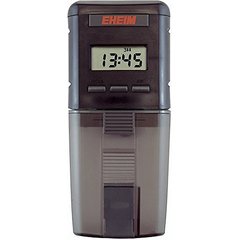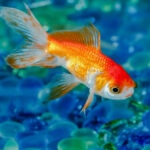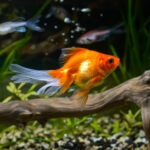How To Choose the Best Automatic Fish Feeder for Aquariums

Photo by Portra/E+
Automatic fish feeders dispense predetermined amounts of food to your fish. These gadgets have many benefits and are great to use when going on vacation or when you’re traveling.
Fish hobbyists can thoroughly research the four styles of automatic fish tank feeders and select which type works best for their tank.
Key Takeaways
- There are four styles of auto feeders: drum, auger, vacation, and Wi-Fi.
- Consider a feeder’s storage capacity, the type of food it's able to hold, how it’s programmed, and how it’s powered.
- Keep in mind the types of fish and the number of fish in your tank or pond.
Benefits of Using an Automatic Fish Feeder
One of the easiest ways to feed your fish is by using an automatic feeder. Auto feeders can be beneficial for many reasons, including:
- Feed the correct amount—Food is measured for each feeding, preventing your fish from being overfed or underfed.
- Promote good water quality—A set amount of food helps ensure your aquarium has good water quality, since there will be minimal food waste.
- Great for traveling—Fish food auto feeders are a great way to make sure your fish are getting fed when you go on vacation.
Types of Automatic Fish Feeders
There are many different types of auto feeders, and it’s important to utilize the one that works best for your needs.
- Drum feeder: The most common type of auto feeder that dispenses a predetermined amount of food and works well with foods like pellets and flakes
Recommended Product
2. Auger feeder: Dispenses a pre-selected amount of food and works well with smaller-sized foods and pellets
Recommended Product
3. Vacation block: A timed-release product primarily used in freshwater tanks and a good option for bottom-dwelling species
Recommended Product
4. Wi-Fi fish feeder: Uses Wi-Fi to connect to your aquarium controller, providing you feeding data or enabling you to add supplemental feeds even if you are not in front of your tank
Key Automatic Feeder Features To Consider
While the concept of an aquarium automatic fish food feeder is generally the same, each type is a little bit different.
Automatic aquarium fish feeder design is important to keep in mind when selecting one for your tank. Make sure to consider the following:
- Food compatibility: Will the food you plan to feed your fish fit in the dispenser opening on the auto feeder?
- Storage capacity: If you are trying to feed a tank that requires a large amount of food, you want to make sure the feeder has enough storage space for those foods.
- Moisture control: Automatic fish feeders are typically positioned over the top of the tank in a naturally humid and moist environment. This can sometimes cause the food inside the dispenser to clump together or spoil. Consider one that has a storage chamber that seals between feedings.
- Programmability: Make sure the feeder is able to be programmed for the number of feeds you wish to provide your tank each day. Not all aquarium fish food feeders are Wi-Fi-capable.
- Power source: Most aquarium auto feeders use AA batteries. However, some of the smart auto feeders may need to be plugged into a control board and a power source.
- Ease of cleaning: Cleaning requirements for each style of auto feeder are different. Drum feeders may be easier to clean than some of the auger-style feeders, which could require additional tools such as a small pipe cleaner or brush.
Choosing an Auto Feeder Based on Your Aquarium Setup
Depending on the size of your aquarium and the number of fish living in it, you might need more than one auto feeder.
The type of fish living in your tank is also something to consider. For example, bottom-dwelling fish may benefit more from a vacation-style feeder. Fish who eat at the surface, like bettas, will appreciate a drum-style auto feeder.
If you have a large pond, you’re going to want an appropriately sized feeder, like this one that holds 30 cups of food.
Recommended Product
Feeder Installation and Setup Tips
Every manufacturer’s aquarium auto feeder is different. Make sure to follow the instructions provided with the one you purchase. Consider some of these tips to help with your setup:
- Add a small mounted platform for your auto feeder to sit on so only the dispenser opening is over the tank. This helps reduce corrosion on the batteries and allows the auto feeder to last longer.
- Try to place it in a central location, above a circulation pump or your main return line. If your tank is large, consider placing one feeder on either side of the tank. Try not to place your auto feeder directly in front of your filter intake.
- Test your feeder over a napkin or plate prior to installing it to ensure you’re providing the correct amount of food. This way, if there’s a problem it’s a lot easier to fix.
- Run the feeder for a couple of days prior to leaving for vacation to ensure everything is working correctly.
The best automatic fish feeder is the one that is easy for you to care for. Fish tank feeders are just like any other piece of equipment on your aquarium, and should be regularly cleaned and maintained. Ultimately you should choose the one that fits the needs of your tank or pond and the animals in it.
FAQs About Automatic Fish Feeders
How do automatic fish feeders work?
Automatic fish feeders are devices used to provide a set amount of food to your fish at each serving. These feeders are often programmed by you to ensure optimal feeding for your fish.
What are the disadvantages of automatic fish feeders?
Disadvantages to using an automatic fish feeder include spoiled food, accidental overfeeding if not set up properly, and dead batteries, causing a feeding to be skipped. Additionally, due to its proximity to the tank, there is risk of a feeder accidentally getting knocked into the water.
How long should a fish feeder run?
The length of time a fish feeder should run depends on the brand of the feeder and how it is programmed. Aim to provide enough food that your fish can consume in about five minutes.







